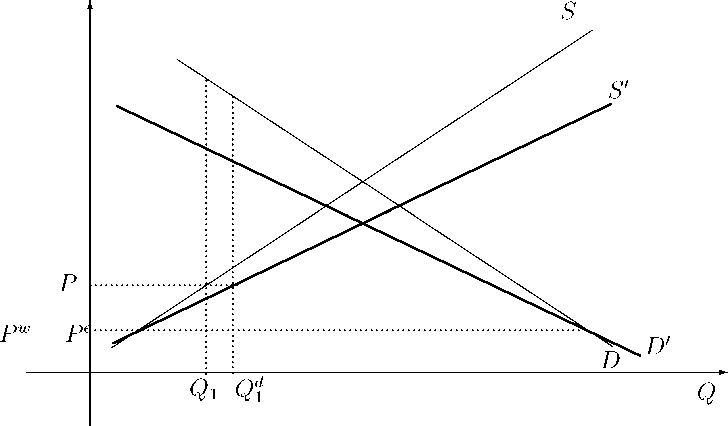P

Figure 3: Domestic price control together with exclusion of foreign suppliers
being maintained at the union-set wage rate, while other workers, including migrants, will
be active on a market track where wages are determined completely by supply and demand.
More generally, we illustrate our argument considering a small open economy for which the
status quo policy involves price setting in the domestic market, which is closed to foreign
competition (i.e. no immigrants are admitted in the country in the original equilibrium).
Notice that this is a special case for what we will generally refer to as involuntary exclu-
sion/participation. Here foreign competitors are involuntarily excluded from the domestic
market thanks to the status quo government policy.
Let P be the first period price, which has been set higher than the world price Pw
leading to excessive demand. Figure 3 illustrates the outcome when dual track liberalization
is expected to be implemented in the second period. As discussed earlier, the first period
strategic demand D0 rotates around the the first period actual demand D at Pe, the second
period equilibrium price for the market track, and the same will happen for the first period
strategic supply S0 . Differently from the single intervention case, the equilibrium price in the
market track will now be determined in international markets, so that Pe = Pw . Accordingly,
in spite of the excessive demand in the first period, dual track liberalization leads to an
equilibrium price in the market track lower than the first period price, i.e. Pe < P. As a
11
More intriguing information
1. The name is absent2. Understanding the (relative) fall and rise of construction wages
3. Modelling Transport in an Interregional General Equilibrium Model with Externalities
4. Financial Market Volatility and Primary Placements
5. The name is absent
6. The name is absent
7. IMPLICATIONS OF CHANGING AID PROGRAMS TO U.S. AGRICULTURE
8. The name is absent
9. Categorial Grammar and Discourse
10. Government spending composition, technical change and wage inequality